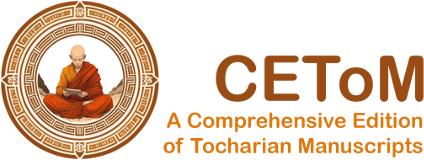PK AS 16.6.2
| Known as: | PK AS 16.6.2; Pelliot Koutchéen Ancienne Série 16.6.2; PK AS 16.6B |
|---|---|
| Cite this page as: | Georges-Jean Pinault; Melanie Malzahn (collaborator). "PK AS 16.6.2". In A Comprehensive Edition of Tocharian Manuscripts (CEToM). Created and maintained by Melanie Malzahn, Martin Braun, Hannes A. Fellner, and Bernhard Koller. https://cetom.univie.ac.at/?m-pkas1662 (accessed 08 Jul. 2025). |
Edition | |
| Editor: | Georges-Jean Pinault; Melanie Malzahn (collaborator) |
Provenience | |
| Main find spot: | Duldur-akur |
| Collection: | Bibliothèque nationale de France, fonds Pelliot Koutchéen (Paris) |
Language and Script | |
| Language: | TB |
| Linguistic stage: | classical |
| Script: | classical |
Text contents | |
| Title of the work: | Supriyanāṭaka |
| Text genre: | Literary |
| Text subgenre: | Drama |
| Verse/Prose: | prose; verse |
Object | |
| Material: | ink on paper |
| Form: | Poṭhī |
| Size (h × w): | 12.4 × 17.5 cm |
| Number of lines: | 6 |
| Interline spacing: | 2 cm |
Transliteration
| a1 | – – (·)[k](·) – n(·) ṣ(·) sa k[e] [r]u nta pl(·) r(·) ya[ṃ] ā lo rme bra /// |
|---|---|
| a2 | tau re kau na la reṃ śwe ntsi a ṣā no : ne st·e sā¯ ¯ñä [y]· /// |
| a3 | bra ha spa ti ña kte ○ [w](·) (–) (·)ñ(·) /// |
| a4 | ne sa lyu śai ṣṣe ntse ○ (–) (·)e /// |
| a5 | ste : we śe ññai sa la kle ṣṣai ai /// |
| a6 | (–) [ltu] ne s(·) (·)e u tu mba rcwi s(·)a /// |
| b1 | (·)[ñ](·) [c]c(·) nma l(·) kle [n](·) mā a ll(·) /// |
| b2 | rne lyu śta rwe¯ ¯s su : la kste l(·) /// |
| b3 | p[t]ā ka¯ ¯s• 2 || te ka w[e] ○ (–) ñ(·) /// |
| b4 | te yä nma s̝s̝aṃ • ñä kcī ○ (·)ai (·)[e] /// |
| b5 | yā mo rme[ṃ] dhva jā ggä¯ ¯r wai pe ta rya nau [mi] (·)[e](·) [t](·)¯ ¯ts e /// |
| b6 | r[l]ā¯ ¯ñ(·)ä [k]o ka le pa ñ(·)ī [y]eṃ (–) [tu] meṃ su pri yeṃ ca kra v(·) |
Transcription
| Xx | a1– – ·k· – n· ṣ(e)sa kerunta pl(o)r(i)yaṃ ālorme{ṃ} bra(haspati) (ñakte) /// a2n1 °tau ; rekauna ; lareṃś wentsi ; aṣāno : |
|---|---|
| Xx | nest (c)e sāñ y· /// a3n2 brahaspati ñakte w· – ·ñ· /// a4nesalyu śaiṣṣentse – ·e /// a5ste : |
| Xx | weśeññaisa ; läkleṣṣai ai° /// a6– ltu nes(t) (=w)e utumbar cwi s·a /// b1·ñ·cc(a)nma l(a)klen(e) mā all· /// b2°rne lyuśtär wes su : |
| * | lakste l· ·/// |
|---|---|
| b3 | ptākas 2 ॥ tekawe – ñ· /// |
| b4 | te yänmaṣṣäṃ • ñäkcī(y)ai ·e /// |
| b5 | yāmormeṃ dhvajāggär waipe tarya naumi(y)e(n)t(aṃ)ts e° /// |
| b6 | °r lāñ(c) kokale päñ(ñ)īyeṃ – tumeṃ supriyeṃ cakrav(ārtti) |
Translation
| a1 | ... after having removed together the drums [and] the flutes, (the god) Bra(haspati) ... |
|---|---|
| a2 | ... worthy to tell words to the king. You are (the maker) of this plan ... |
| a3 | ... the god Brahaspati ... |
| a4 | ... oh you being (the savior?) of the world ... |
| a5 | ... with suffering speech ... |
| a6 | ... (you) have gone out, the Udumbara [tree] of this ... |
| b1 | ... in the suffering not ... |
| b2 | ... he illuminated us in ... |
Commentary
Remarks
| This fragment and PK AS 16.6.1 do indeed seem to belong to the same manuscript. Recto and verso are unclear; left side of a leaf with parts of the left margin and the string hole. |
Philological commentary
| n1 | y is probably the beginning of a form from yām- 'to do'. |
|---|---|
| n2 | ○ [w](· – ·)ñ(·) /// or ○ [l](· – ·)ñ(·) ///. |


